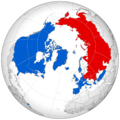Hegemony facts for kids
Hegemony (pronounced with a soft or hard 'g') is the power of one group over other groups. Hegemony is mostly used to refer to relationships between different nations (or countries). This might be direct dominance, such as through military might, but may be indirect dominance, such as when a nation can dictate the terms of trade to its advantage.
Hegemony often describes the relationship of a great power to nearby less powerful countries. The term is Greek, and was first used about the influence of a great city over the cities which were allied to it. Examples are the Peloponnesian League of Sparta (6th to 4th centuries BC); the short-lived Delian League of Classical Athens. The later League of Corinth was headed not by a state, but by Philip II of Macedon. Such a hegemon is a king or ruler with personal power.
A hegemonic relationship is usually described as less than an empire, but more than a regional power. This means a hegemon may not actually take control of other nations, but has the power to greatly influence what they do. On the other hand, a global hegemon is more powerful than, say, Iran is in the Middle East.
Images for kids
-
Ancient Greece under the hegemony of Thebes, 371–362 BC
-
The Roman Empire at its greatest extent, 117 AD
-
The Iberian Union in 1598, under Philip II, King of Spain and Portugal
-
Map of the British Empire (as of 1910). At its height, it was the largest empire in history.
-
The Soviet Union and the United States dominated world affairs during the Cold War
See also
 In Spanish: Hegemonía para niños
In Spanish: Hegemonía para niños






